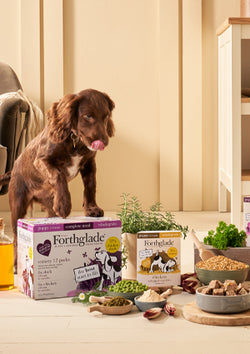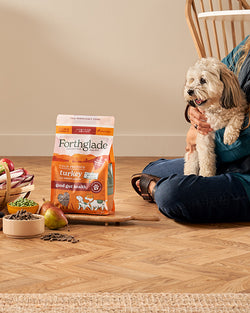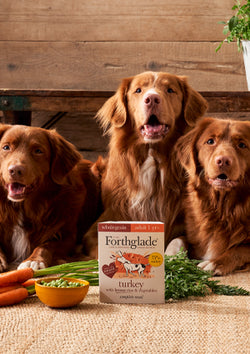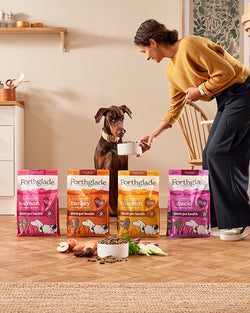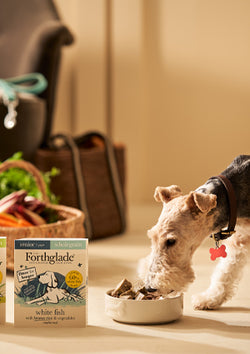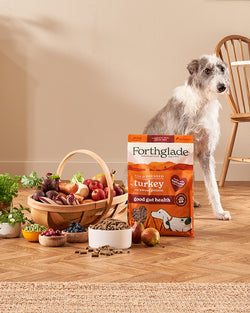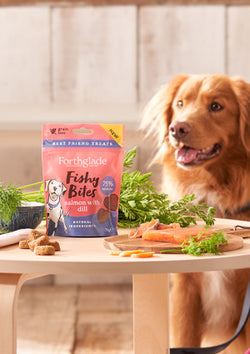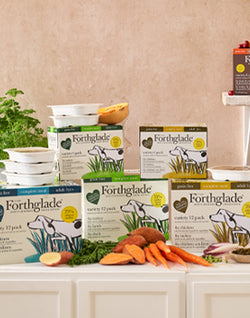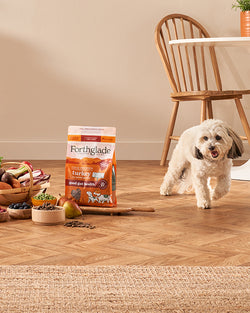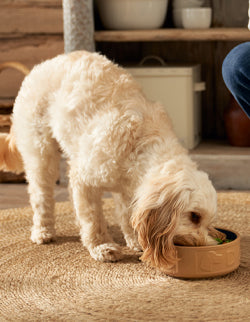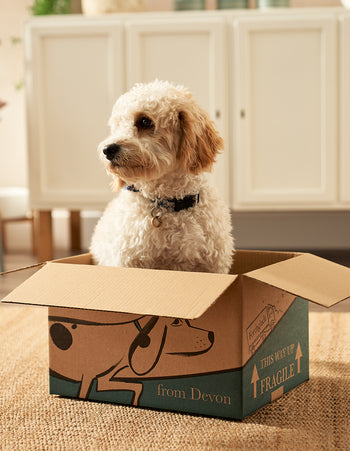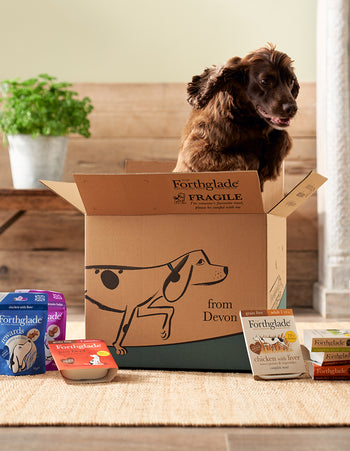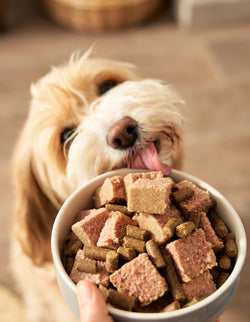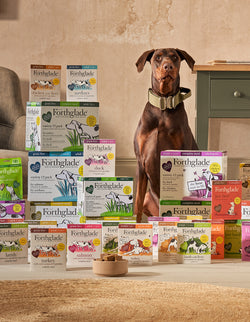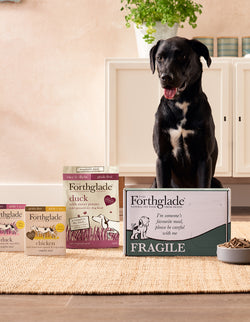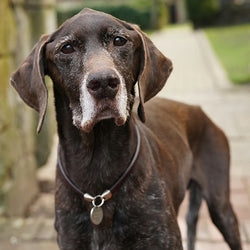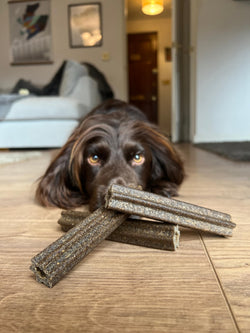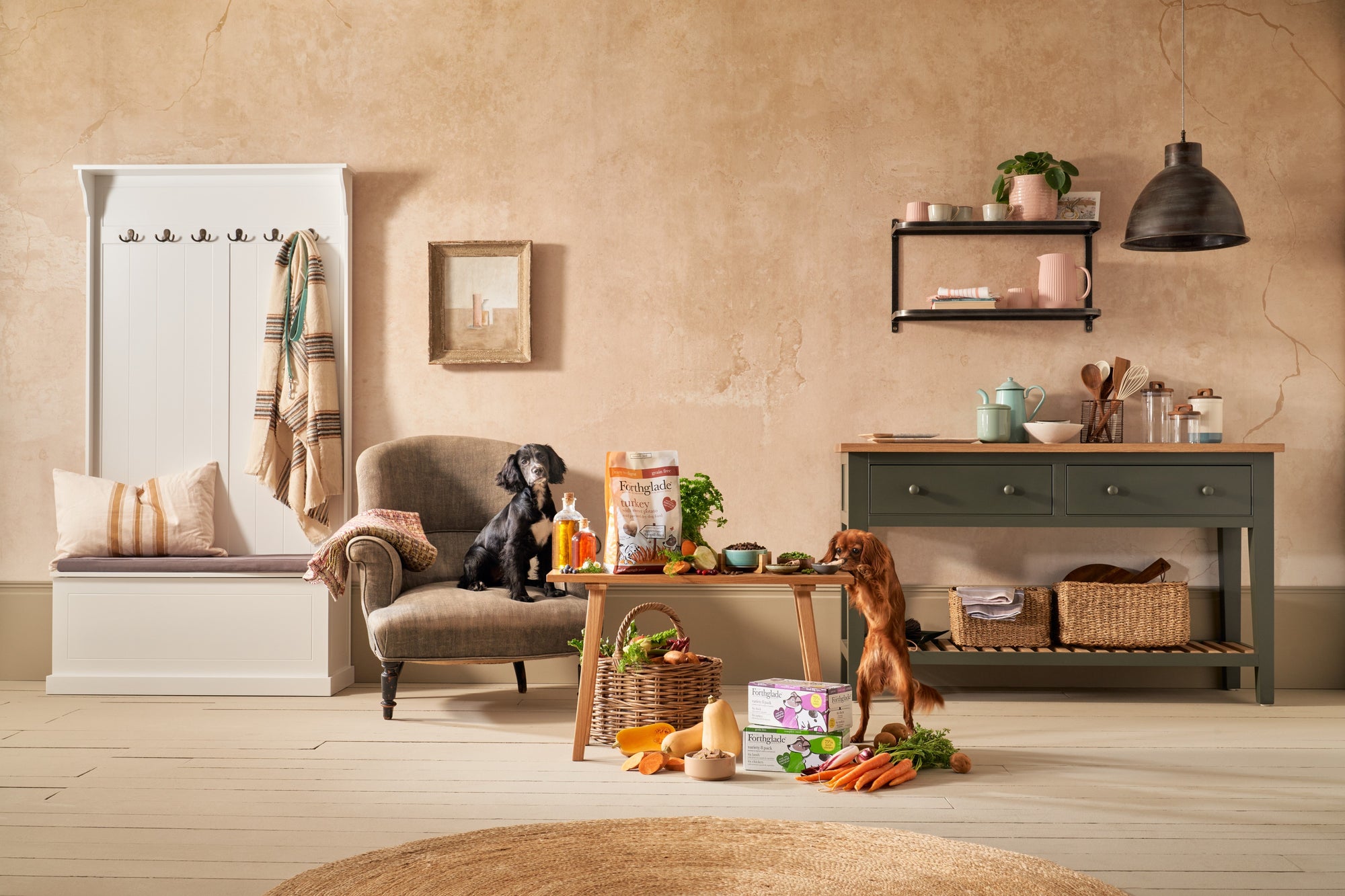Much like humans, our four-legged friends are susceptible to problems with their teeth. Dogs have a whopping 42 adult teeth, compared with 32 for a human (not counting any wisdom teeth), so there’s plenty of opportunity for problems to arise. Here are our top tips for taking care of your dog’s teeth.

Why Are Dogs Susceptible To Dental Disease?
Unlike humans, dogs don’t tend to suffer from serious tooth decay, but staggering statistics show that most dogs over the age of three have dental disease in some form.
Dental disease develops in four stages, starting with a build-up of plaque and tartar, which leads to mildly inflamed gums. This condition is commonly known as gingivitis in dogs. If gingivitis is left untreated, it can then develop into more serious gum disease, known as periodontal disease, which may involve the loss of bone and soft tissue around the teeth.
Gum disease can leave dogs more prone to infections that may even affect other organs in the body.
My Dog’s Losing Teeth – Is This Normal?
Puppies begin losing baby teeth around 12 to 16 weeks of age, so don’t panic if you notice your puppy losing teeth. This is completely normal. By around four months, almost all of a pup’s baby teeth will have fallen out and many of the adult teeth will already be in place.
If your dog loses teeth as an adult, this should be a serious concern and you should speak to your vet as quickly as possible about your dog’s dental hygiene. Much like us humans, dogs cannot regrow adult teeth if they are lost, so we must take good care of them to ensure they remain in tip-top condition throughout your dog’s lifetime.
What Are The Signs Of Dental Disease In Dogs?
- Gradual loss of interest in playing with or chewing toys.
- Fussiness with food, favouring certain types of food (softer foods, for example), eating on one side only or problems picking up food.
- Rubbing or pawing at the mouth.
- Salivating (dribbling) more.
- Pain when you try to examine the mouth.
- Blood in the water or food bowl.
- Smelly breath.
- Red or swollen gums.
- Yellow and brown or missing teeth.
What Should I Do If I Think My Dog Has Dental Disease?
Dental disease in dogs can be extremely painful, particularly if left untreated. It’s vitally important to speak to your vet as early as possible if your dog or puppy is showing any signs of dental disease to avoid both irreversible damage and other health problems.
Research shows pets with periodontal disease are more likely to develop heart, kidney and liver disease. This is the result of bacteria from the gums entering the bloodstream and sticking to the arteries around the heart.
If you haven’t brushed your dog’s teeth and suspect that dental disease may already be present, speak to your vet before you begin brushing as at this point it may be ineffective and could be very painful for your dog.

Top Tips For Good Dog Dental Hygiene
Brushing your dog’s teeth every day might sound like it could be a huge chore! But you can make any interaction with your dog into one that will help deepen your connection. It’ll also give them a mental workout. If time is precious, take five minutes from a daily walk to focus on training and good dental care for dogs.
A good diet, daily brushing and natural dental sticks will help your dog keep their gums and teeth healthy. Don’t be daunted by the prospect of brushing your dog’s teeth. It may take some time to get your dog used to a toothbrush but do persevere! Healthy gums, strong teeth and fresh breath are worth the effort. Following a regular routine at home will help to prevent any dental issues. Here’s what we recommend.
1. Brush Your Dog’s Teeth Regularly
Just like us, brushing your dog’s teeth is the most effective way of removing plaque. There are lots of specifically designed dog toothbrushes that are made using soft bristles and are shaped to fit your pet's mouth.
2. Try Oral Rinses And Gels To Keep Your Dog’s Teeth Healthy
If brushing every day isn’t going to work with your pet, there are lots of oral rinses and gels available that may help slow down the build-up of plaque. This won’t replace the benefits that tooth brushing offers, but can be supportive of overall dental health.
3. Clean Your Dog’s Teeth With A Dental Chew And Toys
Dental chews and toys are designed to help clean your pup’s teeth without them even realising! They’re a great way to help keep plaque at bay in between brushing.
To support your dog’s oral hygiene even further, combine tooth brushing with providing regular dental chews. Natural chews allow your dogs to work their jaws and clean their teeth. Chewing can also help reduce stress and boost happy hormones.
Consider adding in a chew following a particularly exciting (or stressful) walk. Or try one when your dog just seems to need a little relaxed downtime, using it as a delicious and rewarding treat.
- Choose Your Chews Carefully!
If you plan to use dental chews, be aware that these are often high in calories, so you may want to consider cutting back a little on food at mealtimes to prevent your dog gaining weight. Add one of our plant-based dental chews, designed to support your dog’s teeth, gums and breath, to your dog’s daily routine.
4. Book In Regular Oral Check-ups With Your Vet
Regular check-ups with your vet will help to highlight any concerns around your dog's oral health. If your vet recognises any issues, a dental clean-up may be needed. They can suggest carrying out treatment that’s similar to humans, which may include tartar removal, checking the teeth for cavities and gingival (gum) pockets and removing any loose teeth.

When To Start Brushing Your Dog’s Teeth
Teaching dogs to enjoy tooth brushing works most effectively when we start it off in puppyhood. Puppies shouldn’t have any fears of their mouth being looked in, so it’s an ideal time to introduce brushing. Starting off very slowly, when they are young, playful and curious, will set up a relaxing, familiar routine.
That being said, there’s no reason why you can’t teach your old dog new tricks. Any dog, with careful and considerate support, can be taught to like their teeth being brushed or to feel relaxed while being handled.
How Long To Spend Brushing Your Dog’s Teeth
Giving yourself the goal of brushing ALL of your dog’s teeth in one session is setting you both up to fail. Just like we can break down grooming sessions into paws, legs, ears and tummy, so can we break down tooth brushing into a few teeth at a time.
Initially, it might take you a couple of weeks to have covered the whole mouth area. As your dog grows in confidence, you’ll be able to brush larger areas during each session.
As your dog becomes more used to having his teeth brushed, you can increase the frequency and length of your tooth-brushing sessions. Try to aim for at least three times a week or every day if possible, with 30 seconds of brushing on each side of their mouth.
How To Brush Your Dog’s Teeth
When it comes to husbandry tasks like tooth brushing, we tend to stand above our dogs. This means we loom over them and potentially risk them feeling threatened. Sitting down so your head is at a similar height to your dog's will help them feel more at ease.
Or, ask them to hop up onto a sofa or step so they’re slightly higher up than you. When you start brushing, your arms are coming from below instead of above them, which is less threatening.
What To Use To Brush Your Dog’s Teeth
Once your dog is used to being handled around their mouth, introduce a toothbrush. Hold the toothbrush up to your dog’s nose to let them sniff and investigate as they please. Do not allow them to bite the toothbrush, or take it away from you.
Finger Toothbrushes
While a standard dog toothbrush might be easier to use in the long run, starting with a finger toothbrush (or even just your bare finger) can help your dog get used to the brushing sensation or process.
Start by having a little of their favourite wet food on your finger and allow your dog to start licking it. As they enjoy the yummy flavour, slide your finger briefly up under their jowl to the gum area and then back into starting position for more licks.
Over time, build up to sliding your finger around half of their top or lower gum line before allowing them to resume the treat licking. When they’re comfortable with this, then add in your finger toothbrush, before eventually moving over to a standard brush.
Sonic Toothbrushes
If you plan to use a sonic toothbrush, start by simply showing the toothbrush without it being turned on. Provide a tasty treat at the same time. Your dog will start to get excited when the toothbrush appears, as they know it means a treat will soon appear too!
Next, try turning the brush on and straight back off. You can then build up the time the brush runs for.
With a pea-sized amount of toothpaste on your dog’s new toothbrush, introduce the paste and the brush to your dog. Let him sniff it, let him taste it, but do not let him eat it – or before you know it, tooth-brushing time will become all snack and no-brushing time!
Both toothbrushes and dog toothpaste are widely available at your vets and in pet shops. Toothbrushes should be replaced every four to six weeks.
Don't Use Human Toothpaste
Make sure that you always use a toothpaste formulated specifically for dogs, and never use toothpaste intended for humans. Most human toothpaste contains fluoride, which is extremely poisonous for dogs.
Where To Brush Your Dog’s Teeth
While we usually brush our own teeth in the bathroom, your dog may not be so comfortable or familiar in this room. When it comes to starting your dog’s oral hygiene journey, choose an environment they enjoy spending time in.
Give them as much space as possible and an easy exit route should they start to feel overwhelmed or a little anxious.
Turn Brushing Your Dog’s Teeth Into A Trick

Teaching your dog a new trick will help with the brushing process. It’s a great way to get them engaging in the task-based part of their brain, instead of the emotional side. Try working on either your dog opening its mouth on cue, or coming and resting their chin on your hand or leg.
-
‘Capturing’
You can use a method known as ‘capturing’ to get your dog to open their mouth on cue. For this, you need to watch your dog. Every time they naturally perform the desired behaviour, mark it with a clicker or a ‘yes’, then give them a treat.
If your dog doesn’t often open their mouth, you can also set up the situation by putting a treat towards their mouth. When they go to open it, you mark the moment and then let them enjoy the treat.
-
‘Chin Target’
To start teaching a chin target, begin by stroking your dog’s chest. This is hopefully something they’ll enjoy. Once they’re nice and relaxed, slide your hand up from their chest to rest for a second or two under their chin.
As you make contact with that area, mark your dog with a clicker or a ‘yes’ and give them a treat. Slowly build up the amount of time your dog is comfortable with having your hand being placed under their chin.
Remember to keep training sessions short and sweet. Always try to end on a high!
Make Brushing Your Dog’s Teeth Fun
When you start to build up the length of your tooth brushing sessions, try to mix things up. Throw in a game of tug or ask for a favourite trick in between each section of brushing.
Tricks or games that allow your dog to move about are great for helping them to relieve any tension they might be feeling during the brushing process.
Reward your dog for allowing you to brush their teeth
Make sure to reward your furry friend for allowing you to brush their teeth. As with all dog training, treats are a valuable tool in creating an initial link between positive behaviour and reward, so be sure to follow through on this to make tooth-brushing time an exciting (and rewarding) time for your dog.
I Struggle To Brush My Dog’s Teeth. What Should I Do?
First, rest assured that you’re not alone! It’s very common for dogs not to like having their teeth brushed and this can make it very difficult to keep on top of day-to-day brushing, or prevent it altogether.
If your dog finds it very difficult to let you near their mouth, they may have some pain in their mouth or jaw. Ask your vet to take a look, just to make sure there’s no underlying health concerns.
You might also need to have your dog’s teeth professionally cleaned by the vet while you help them to learn to love having their teeth brushed at home. This means when they’re ready to let you take over the oral care, you won’t be dealing with problematic build-ups or gum disease.
A force-free behaviourist will also be able to assist you in supporting your dog to feel more comfortable about being handled.
Build Up A Foundation Of Trust
The first step to getting your dog to be comfortable with brushing their teeth is getting them used to you touching their mouth, teeth and gums. Starting when your dog is a puppy certainly makes teeth brushing easier than trying to train an adult dog to get used to this new sensation.
Be patient, and begin by simply touching your dog’s mouth. Regularly lift their lips so you can see their teeth, open their mouth and gently run your fingers along their teeth and gums. Over time, your dog will become used to this sensation, and they’ll trust that nothing bad comes of it.
Reward Positive Behaviour
Rewarding positive behaviour during this initial introduction using treats may help, too. Hopefully, over time, you’ll feel confident that your dog trusts you to carry out these activities, and any nervousness that may have been there initially will have subsided. Try our calming multi-functional soft bites with turkey, camomile, lavender and lemon balm.
Most importantly, think positively about the process and try not to be in any rush to get to the desired result immediately. Think of tooth brushing as a lovely part of your daily routine together. Build it up slowly, going at a pace that suits you both. It could be the way you start the day, or wind down in the evening. Take your time and eventually you’ll have a lovely new bonding activity.

What Should I Feed My Dog For Good Dental Health?
It’s a common myth that ‘kibble’ or dry food is good for dental health, but it simply isn’t true. We regularly speak to dog owners who even believe that their dog’s teeth will fall out if they don’t have something crunchy in their dinner!
This misguided advice has historically been provided by vets and other dog owners. It's driven many dog owners to choose a heat-extruded dry food diet for their dog, a process that removes most of the vitamins and minerals from the food and often packs it with unnecessary junk and fillers.
Choose Natural, High Quality Dog Food
The truth is, most kibble is too small to do any good. There’s just not enough chewing going on. Feeding kibble doesn’t promote cleaner teeth at the gum line, where it really matters. However, a natural healthy diet can certainly help to maintain your dog’s overall health, including their teeth and gums.
At Forthglade, we focus on high-quality wet and dry dog food made from natural ingredients, plus added vitamins and minerals to keep your four-legged friend healthy from the tip of their tail to their pearly whites. Explore our range of wet and dry recipes.
This article is supported by Caroline Wilkinson, a certified Animal Behaviourist.
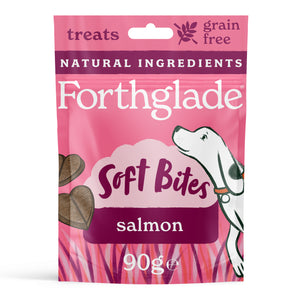
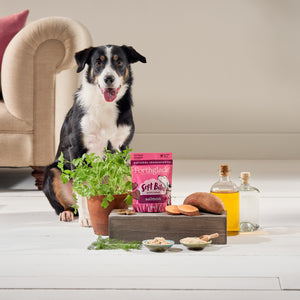
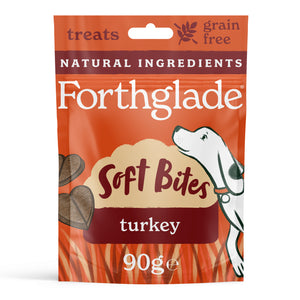

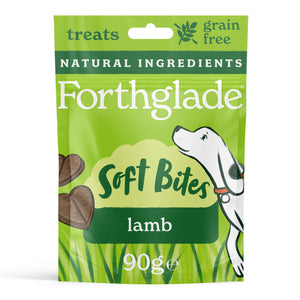
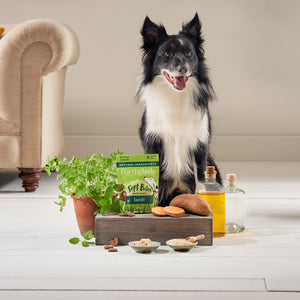


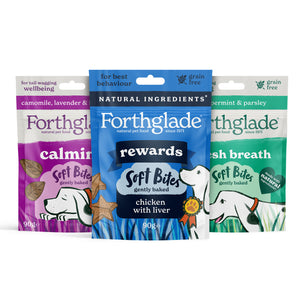



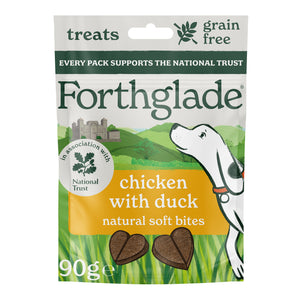





 Over 9,000 5* Reviews
Over 9,000 5* Reviews
 Subscribe for 10% Off Every Order
Subscribe for 10% Off Every Order


